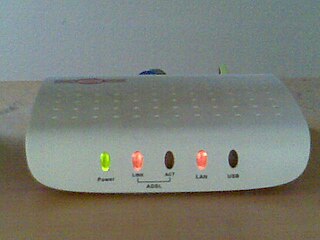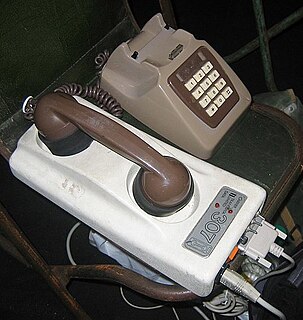Related Research Articles

Fax, sometimes called telecopying or telefax, is the telephonic transmission of scanned printed material, normally to a telephone number connected to a printer or other output device. The original document is scanned with a fax machine, which processes the contents as a single fixed graphic image, converting it into a bitmap, and then transmitting it through the telephone system in the form of audio-frequency tones. The receiving fax machine interprets the tones and reconstructs the image, printing a paper copy. Early systems used direct conversions of image darkness to audio tone in a continuous or analog manner. Since the 1980s, most machines modulate the transmitted audio frequencies using a digital representation of the page which is compressed to quickly transmit areas which are all-white or all-black.
A personal communications service (PCS) is set of communications capabilities that provide a combination of terminal mobility, personal mobility, and service profile management. This class of services comprises several types of wireless voice or wireless data communications systems, typically incorporating digital technology, providing services similar to advanced cellular mobile or paging services. In addition, PCS can also be used to provide other wireless communications services, including services that allow people to place and receive communications while away from their home or office, as well as wireless communications to homes, office buildings and other fixed locations. Described in more commercial terms, PCS is a generation of wireless cellular-phone technology, that combines a range of features and services surpassing those available in analogue- and first-generation (2G) digital-cellular phone systems, providing a user with an all-in-one wireless phone, paging, messaging, and data service.
Digital subscriber line is a family of technologies that are used to transmit digital data over telephone lines. In telecommunications marketing, the term DSL is widely understood to mean asymmetric digital subscriber line (ADSL), the most commonly installed DSL technology, for Internet access.
The U interface or U reference point is a Basic Rate Interface (BRI) in the local loop of an Integrated Services Digital Network (ISDN), connecting the network terminator (NT1/2) on the customer's premises to the line termination (LT) in the carrier's local exchange, in other words providing the connection from subscriber to central office.
Voice over Internet Protocol (VoIP), also called IP telephony, is a method and group of technologies for the delivery of voice communications and multimedia sessions over Internet Protocol (IP) networks, such as the Internet. The terms Internet telephony, broadband telephony, and broadband phone service specifically refer to the provisioning of communications services over the Internet, rather than via the public switched telephone network (PSTN), also known as plain old telephone service (POTS).

G.711 is a narrowband audio codec originally designed for use in telephony that provides toll-quality audio at 64 kbit/s. G.711 passes audio signals in the range of 300–3400 Hz and samples them at the rate of 8,000 samples per second, with the tolerance on that rate of 50 parts per million (ppm). Non-uniform (logarithmic) quantization with 8 bits is used to represent each sample, resulting in a 64 kbit/s bit rate. There are two slightly different versions: μ-law, which is used primarily in North America and Japan, and A-law, which is in use in most other countries outside North America.
The HomePNA Alliance is an incorporated non-profit industry association of companies that develops and standardizes technology for home networking over the existing coaxial cables and telephone wiring within homes, so new wires do not need to be installed.
Very high-speed digital subscriber line (VDSL) and very high-speed digital subscriber line 2 (VDSL2) are digital subscriber line (DSL) technologies providing data transmission faster than the earlier standards of asymmetric digital subscriber line (ADSL) G.992.1, G.992.3 (ADSL2) and G.992.5 (ADSL2+).

3G is the third generation of wireless mobile telecommunications technology. It was the upgrade over 2G, 2.5G, GPRS and 2.75G EDGE networks, offering faster data transfer, and better voice quality. This network was superseded by 4G, and later on 5G. This network is based on a set of standards used for mobile devices and mobile telecommunications use services and networks that comply with the International Mobile Telecommunications-2000 (IMT-2000) specifications by the International Telecommunication Union. 3G finds application in wireless voice telephony, mobile Internet access, fixed wireless Internet access, video calls and mobile TV.
4G is the fourth generation of broadband cellular network technology, succeeding 3G, and preceding 5G. A 4G system must provide capabilities defined by ITU in IMT Advanced. Potential and current applications include amended mobile web access, IP telephony, gaming services, high-definition mobile TV, video conferencing, and 3D television.
Single-pair high-speed digital subscriber line (SHDSL) is a form of symmetric digital subscriber line (SDSL), a data communications technology for equal transmit and receive data rate over copper telephone lines, faster than a conventional voiceband modem can provide. As opposed to other DSL technologies, SHDSL employs trellis-coded pulse-amplitude modulation (TC-PAM). As a baseband transmission scheme, TC-PAM operates at frequencies that include those used by the analog voice plain old telephone service (POTS). As such, a frequency splitter, or DSL filter, cannot be used to allow a telephone line to be shared by both an SHDSL service and a POTS service at the same time. Support of symmetric data rates made SHDSL a popular choice by businesses for private branch exchange (PBX), virtual private network (VPN), web hosting and other data services.

G.992.5 is an ITU-T standard for asymmetric digital subscriber line (ADSL) broadband Internet access. The standard has a maximum theoretical downstream sync speed of 24 megabits per second (Mbit/s). Utilizing G.992.5 Annex M upstream sync speeds of 3.3 Mbit/s can be achieved.
A duplex communication system is a point-to-point system composed of two or more connected parties or devices that can communicate with one another in both directions. Duplex systems are employed in many communications networks, either to allow for simultaneous communication in both directions between two connected parties or to provide a reverse path for the monitoring and remote adjustment of equipment in the field. There are two types of duplex communication systems: full-duplex (FDX) and half-duplex (HDX).
Dynamic bandwidth allocation is a technique by which traffic bandwidth in a shared telecommunications medium can be allocated on demand and fairly between different users of that bandwidth. This is a form of bandwidth management, and is essentially the same thing as statistical multiplexing. Where the sharing of a link adapts in some way to the instantaneous traffic demands of the nodes connected to the link.

H.323 is a recommendation from the ITU Telecommunication Standardization Sector (ITU-T) that defines the protocols to provide audio-visual communication sessions on any packet network. The H.323 standard addresses call signaling and control, multimedia transport and control, and bandwidth control for point-to-point and multi-point conferences.
T.38 is an ITU recommendation for allowing transmission of fax over IP networks (FoIP) in real time.
Latency refers to a short period of delay between when an audio signal enters a system and when it emerges. Potential contributors to latency in an audio system include analog-to-digital conversion, buffering, digital signal processing, transmission time, digital-to-analog conversion and the speed of sound in the transmission medium.

Asymmetric digital subscriber line (ADSL) is a type of digital subscriber line (DSL) technology, a data communications technology that enables faster data transmission over copper telephone lines than a conventional voiceband modem can provide. ADSL differs from the less common symmetric digital subscriber line (SDSL). In ADSL, bandwidth and bit rate are said to be asymmetric, meaning greater toward the customer premises (downstream) than the reverse (upstream). Providers usually market ADSL as an Internet access service primarily for downloading content from the Internet, but not for serving content accessed by others.

A modulator-demodulator or modem is a computer hardware device that converts data from a digital format into a format suitable for an analog transmission medium such as telephone or radio. A modem transmits data by modulating one or more carrier wave signals to encode digital information, while the receiver demodulates the signal to recreate the original digital information. The goal is to produce a signal that can be transmitted easily and decoded reliably. Modems can be used with almost any means of transmitting analog signals, from light-emitting diodes to radio.
Echo suppression and echo cancellation are methods used in telephony to improve voice quality by preventing echo from being created or removing it after it is already present. In addition to improving subjective audio quality, echo suppression increases the capacity achieved through silence suppression by preventing echo from traveling across a telecommunications network. Echo suppressors were developed in the 1950s in response to the first use of satellites for telecommunications.
References
- ↑ "ITU-T Recommendation database". ITU. Retrieved 2017-12-30.